
Caladenia dimidia, commonly known as the chameleon orchid is a species of orchid endemic to the south-west of Western Australia. It has a single hairy leaf and one or two yellow, cream-coloured or pinkish flowers. It is a variable species, similar to the Joseph's spider orchid but has a more northerly distribution and smaller flowers.
Caladenia denticulata subsp. albicans, commonly known as the alabaster spider orchid, is a plant in the orchid family Orchidaceae and is endemic to the south-west of Western Australia. It has a single erect, hairy leaf and one or two pale creamy-white flowers which have a white labellum with red markings. The only known population occurs in a small area near Arrowsmith.
Caladenia denticulata subsp. rubella, commonly known as the clumped spider orchid, is a plant in the orchid family Orchidaceae and is endemic to the south-west of Western Australia. It has a single erect, hairy leaf and one or two dull or pinkish red flowers with prominent dull red markings and with a white labellum with red markings.

Caladenia dundasiae, commonly known as the Patricia's spider orchid and Dundas spider orchid is a species of orchid endemic to a small area in the south-west of Western Australia. It is a rare orchid with a single hairy leaf and one or two, usually red flowers with thin, stiffly-held lateral sepals and petals.
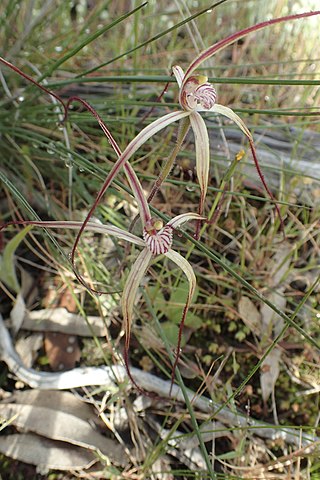
Caladenia erythronema, commonly known as the red thread spider orchid, and Nyabing spider orchid is a plant in the orchid family Orchidaceae and is endemic to the south-west of Western Australia. It has a single hairy leaf and up to three red, yellow or cream-coloured flowers with dangling, thread-like sepals and petals and a small labellum.
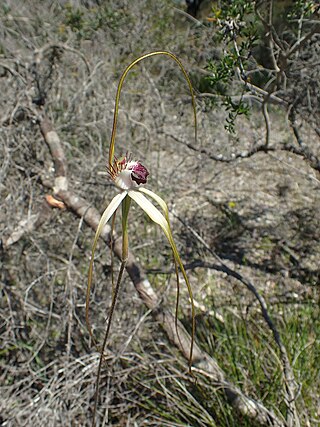
Caladenia excelsa, commonly known as the giant spider orchid, is a species of orchid endemic to a small area in the south-west of Western Australia. It is a rare species with a single, hairy leaf and up to three cream-coloured to greenish-cream flowers with long, drooping sepals and petals. It is one of the tallest spider orchids in Western Australia and, with Caladenia splendens, has the largest flowers of any Western Australian orchid.

Caladenia exilis subsp. exilis, commonly known as the salt lake spider orchid, is a plant in the orchid family Orchidaceae and is endemic to the south-west of Western Australia. It is a relatively common spider orchid with a single erect, hairy leaf and up to three white to greenish-cream flowers with a small white, red-striped labellum.
Caladenia exilis subsp. vanleeuwenii, commonly known as the Moora spider orchid, is a plant in the orchid family Orchidaceae and is endemic to the south-west of Western Australia. It is a relatively rare spider orchid with a single erect, hairy leaf and up to three variably-coloured flowers with a small white, red-striped labellum. It differes from subspecies exilis in having variably coloured flowers, different growth habit, earlier flowering and different habitat.
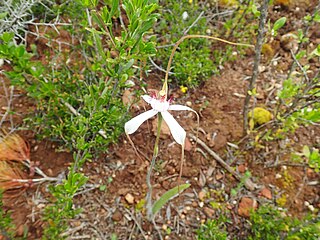
Caladenia longicauda subsp. clivicola, commonly known as the Darling Scarp white spider orchid, or hills white spider orchid is a plant in the orchid family Orchidaceae and is endemic to the south-west of Western Australia. It has a single hairy leaf and up to three mostly white flowers with long, drooping lateral sepals and petals, a relatively small, narrow labellum and narrow labellum teeth. It grows in a restricted area, mostly on the Darling Scarp.
Caladenia melanema, commonly known as the ballerina orchid, is a species of orchid endemic to the south-west of Western Australia. It is a rare orchid with a single erect, hairy leaf and one or two cream-coloured to pale yellow flowers with red markings and black tips on the sepals and petals.

Caladenia pendens subsp. pendens, commonly known as the pendant spider orchid, is a plant in the orchid family Orchidaceae and is endemic to the south-west of Western Australia. It has a single hairy leaf and up to three relatively large, creamy-white flowers with long drooping petals and sepals and sometimes has a sickly-sweet scent.

Caladenia pendens subsp. talbotii, commonly known as Talbot's spider orchid, is a plant in the orchid family Orchidaceae and is endemic to the south-west of Western Australia. It has a single hairy leaf and one or two white, red and yellow flowers with long drooping petals and sepals and sometimes has a citrus-like scent.
Caladenia pholcoidea subsp. pholcoidea, commonly known as the Albany spider orchid, is a plant in the orchid family Orchidaceae and is endemic to the south-west of Western Australia. It has a single hairy leaf and up to four pale yellow flowers with long drooping petals and lateral sepals.
Caladenia pholcoidea subsp. augustensis, commonly known as the Augustus spider orchid, is a plant in the orchid family Orchidaceae and is endemic to the south-west of Western Australia. It is a rare orchid with a single hairy leaf and up to three mostly white flowers with long spreading petals and lateral sepals.

Caladenia radialis, commonly known as the drooping spider orchid, is a species of orchid endemic to the south-west of Western Australia. It has a single erect, hairy leaf and one or two red and cream-coloured flowers. In good seasons it forms clumps of up to ten plants.

Caladenia remota subsp. parva, commonly known as the Perenjori spider orchid, is a plant in the orchid family Orchidaceae and is endemic to the south-west of Western Australia. It has a single hairy leaf and up to three creamy-white to pale yellow flowers. It has a more restricted and more westerly distribution than subspecies remota.

Caladenia uliginosa subsp. candicans, commonly known as the northern darting spider orchid, is a plant in the orchid family Orchidaceae and is endemic to the south-west of Western Australia. It has a single hairy leaf and up to three yellowish-cream flowers which have a forward-projecting labellum lacking the red tip of subspecies uliginosa.
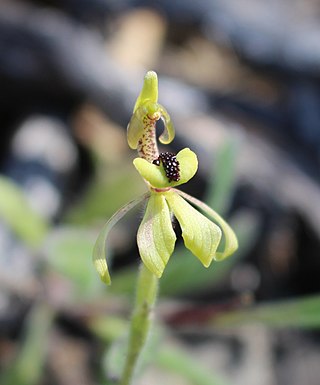
Caladenia bryceana is a species of flowering plant in the orchid family Orchidaceae and is endemic to the south-west of Western Australia. It is a dwarf spider orchid with a single spreading, hairy leaf and a single green to apricot-coloured flower. There are two subspecies differing in the features of the labellum.
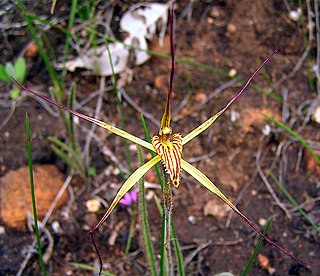
Caladenia caesarea is a species of flowering plant in the orchid family Orchidaceae and is endemic to the south-west of Western Australia. It is a ground orchid with a single erect, hairy leaf and up to three mustard-coloured or lemon-yellow flowers.

Caladenia exilis is a species of flowering plant in the orchid family Orchidaceae and is endemic to the south-west of Western Australia. It is a ground orchid with a single erect, linear leaf and up to three white to greenish-cream or dark pinkish-maroon flowers.













